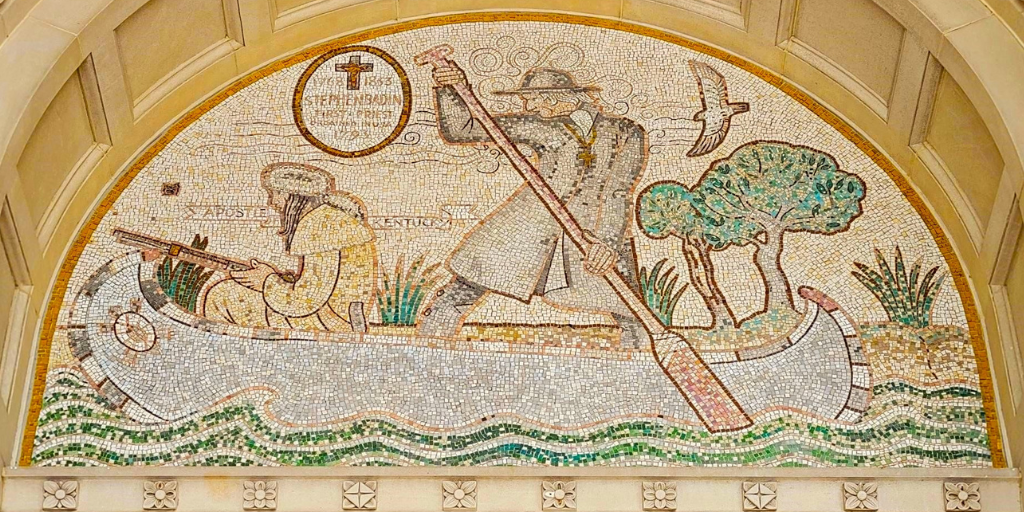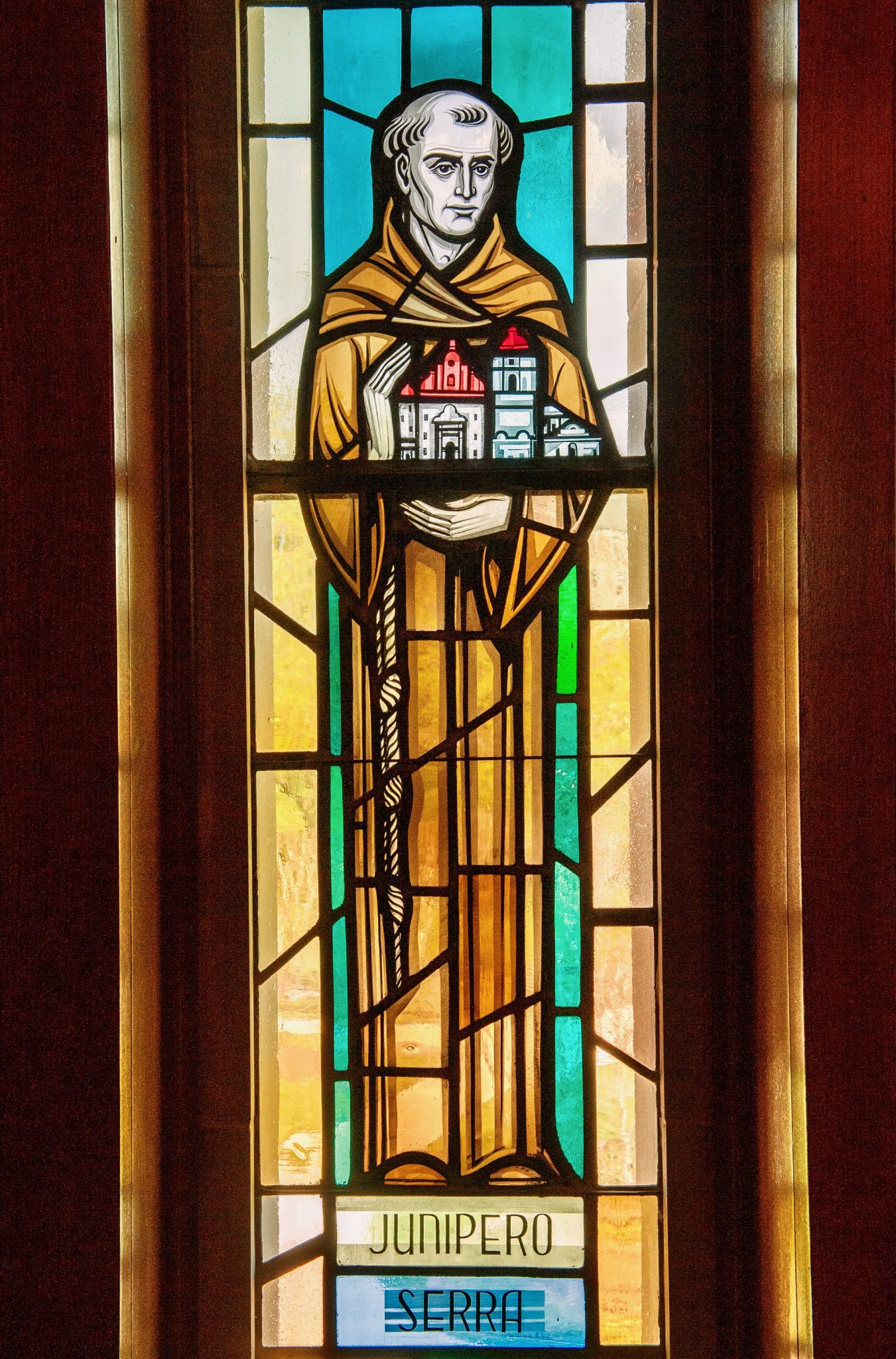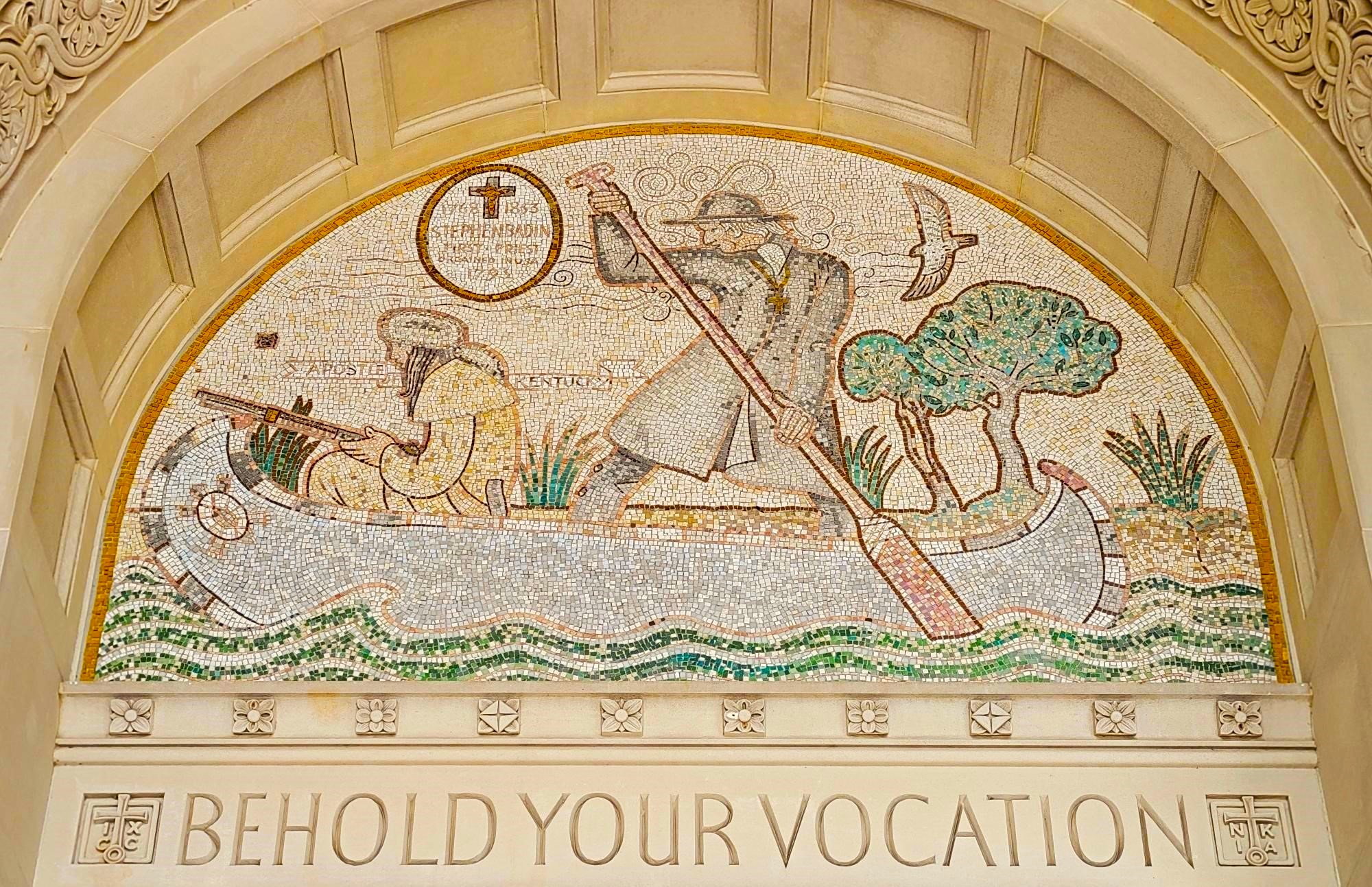
“But you will receive power when the Holy Spirit comes upon you, and you will be my witnesses in Jerusalem,
throughout Judea and Samaria, and to the ends of the earth.” – Acts 1:8
Throughout history, many brave souls have dared to venture across the seas to unknown lands, determined to bring the Gospel to those who have never heard it. For these believers, sharing the Gospel often came with costs – from natural dangers to health risks. Yet despite the obstacles, they pressed on, motivated by a zeal for the Lord.
In our latest series, we’re exploring the stories of Catholic missionaries portrayed in the art of the Basilica, from St. Junípero Serra to St. Marianne Cope. This first installment focuses on three missionaries who were trailblazers, braving the wild terrains of the New World to share the Gospel.
1. Ven. Eusebio Kino

Over the course of his lifetime, Eusebio Kino served in turns as a missionary, cosmographer, explorer, and diplomat. Born in the Italian Alps in 1645, he joined the Society of Jesus at age 21 and was ordained in 1677. He ministered to the Italian people until 1681, when he set sail for the New World. In the year that followed, he was selected to be the royal cosmographer and a missionary on the California Expedition. Eusebio worked in Baja and San Bruno until eventually settling in the Pímeria Alta. There, he founded mission communities among the O’odham people and taught them new technologies and agricultural techniques that would enable them to be independent in the colonized world.
Padre Kino repeatedly protected the O’odham people against enslavement and mistreatment. On one occasion, he rode 1,500 miles on horseback in seven weeks to personally deliver a written complaint to colonial officials denouncing the unjust treatment of the O’odham. By the end of his life, Padre Kino had founded 24 missions and baptized over 4,500 people.
Aside from his mission work, Kino also distinguished himself as an intrepid explorer, trailblazing new lands beyond the Spanish frontiers. His 50 distinct expeditions included discovery of a land passage to California, which corrected a misconception of the time that the area was an island. Kino also created more accurate maps of the region, which became the authoritative references used for the next 150 years. In the Basilica, you can find him portrayed in mosaic in one of the east portico tympanum.
2. St. Junípero Serra

Did you know that St. Junípero Serra’s canonization was the first to take place on U.S. soil? Presided over by Pope Francis on September 23, 2015, it was also the first canonization ever to take place at the Basilica of the National Shrine of the Immaculate Conception.
Known as “the Apostle to California,” Junípero Serra was instrumental in introducing the Gospel to the Americas. Born in Petra, Majorca, Spain in 1713, he joined the Franciscan order at the age of 16 and earned his doctorate at Lullian University before coming to America in 1749. Like Padre Kino, Serra often defended Indigenous people from government overreach, and was known for teaching both religious truths and agricultural skills with care and passion. He even learned one of the Native American languages in order to share the Gospel more effectively, and founded a total of nine missions across California.
It is estimated that over the course of his ministry, Junípero Serra baptized over 6,700 Indigenous people and confirmed over 4,500. Despite suffering from a variety of medical conditions that often made traveling extremely uncomfortable, he made many long journeys on foot. During one trip, he walked a total of 1,700 miles! At the age of 70, Serra passed away at Mission San Carlos, where he was also buried.
3. Fr. Stephen Theodore Badin

On July 17, 1768, Stephen Theodore Badin was born in Orleans, France. After studying at Montaigu College in Paris, Badin attended the Sulpician Seminary in Orleans for two years until the school closed during the French Revolution in 1791. That November, he sailed to America with four other men, with the goal of serving as a priest in the young country. They landed in Philadelphia in March of 1792, and within a year, Badin finished his theological training at a newly established seminary in Baltimore, Maryland. On May 25, 1793, shortly before his 25th birthday, Badin became the first priest to be ordained in the United States and was soon sent to serve at the Mission in Kentucky. In his new position, Badin often had to travel long distances to assist his parishioners at various settlements, and at one point, he was needed in so many places at once that he had to spend over three weeks on horseback.
Throughout this period of his ministry, Badin helped build new churches and establish congregations in addition to his regular duties. In 1819, Badin was called back to France, where he worked for nine years before returning to the United States. From Michigan to Indiana, he ministered to various communities across the nation, serving both Catholic and Potawatomi Indian populations. During his travels, Badin would often locate and buy properties he considered suitable for the establishment of future churches; one such property eventually became the location of Notre Dame University! After a lifetime of serving others, Badin eventually passed away in Cincinnati, Ohio, in April 1853. You can find Fr. Stephen Theodore Badin portrayed in one of the mosaic tympanum of the east portico.
Sources:
Butler’s Lives of the Saints, ed. Bernard Bangley.
“Eusebio Francesco Chini,” Dicastery for the Causes of Saints.
“Eusebio Francisco Kino,” National Park Service.
“Padre Kino – Our Padre on Horseback,” Kino Heritage Society.
“Padre Kino Biography,” Kino Historical Society.
Rohling, Geraldine M., PhD, MAEd. The Basilica of the National Shrine of the Immaculate Conception: Guide and Tour Book. Washington, D.C.: Basilica of the National Shrine of the Immaculate Conception, 2018.
Rohling, Geraldine M., PhD, MAEd. “The Cause of Junípero Serra.”
“Saint Junípero Serra,” USCCB.
“Stephen Theodore Badin,” New Advent.
The Way of Saints, Tim Cowan.
“Who Was Stephen Badin?” Notre Dame Magazine.


